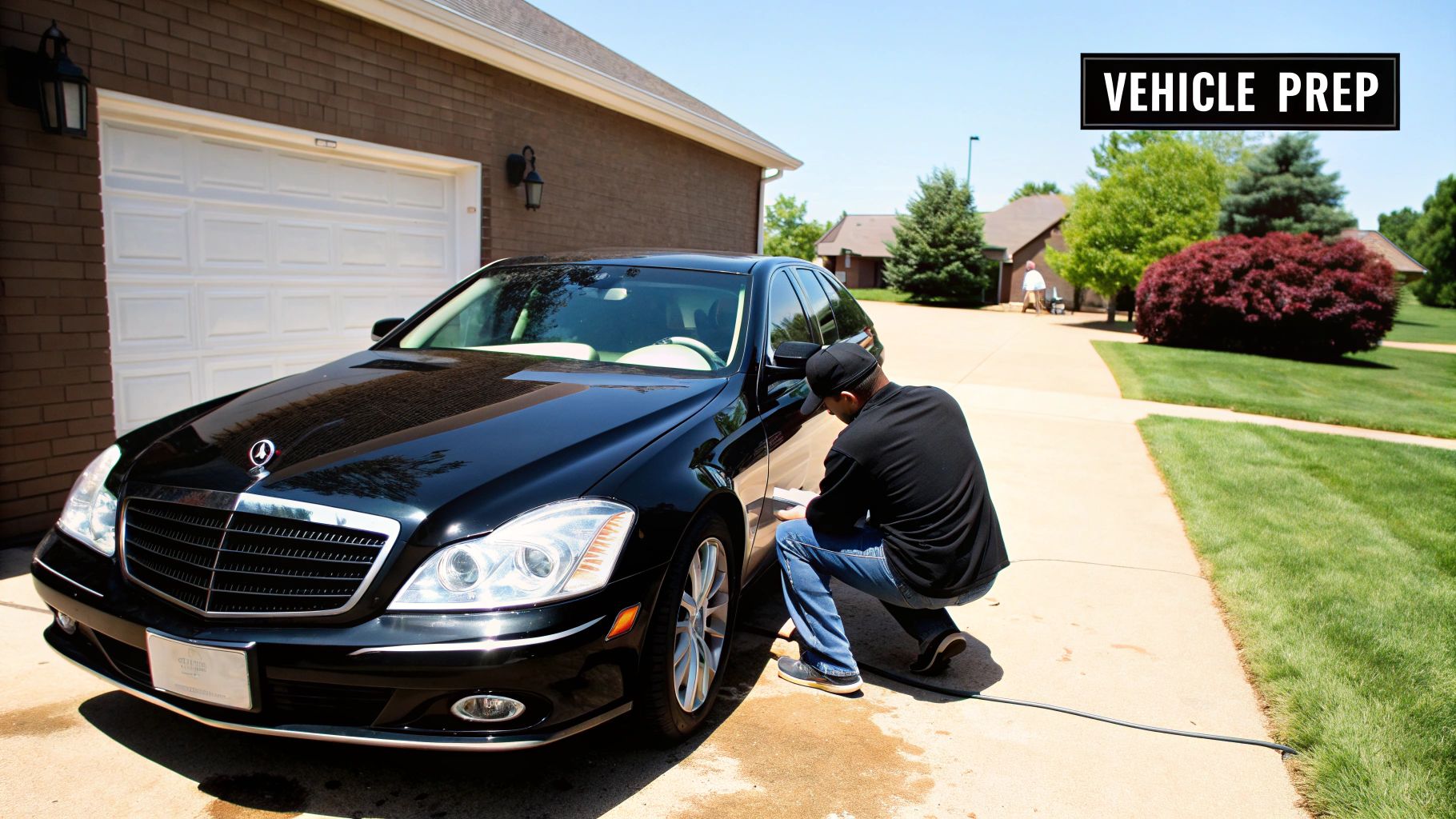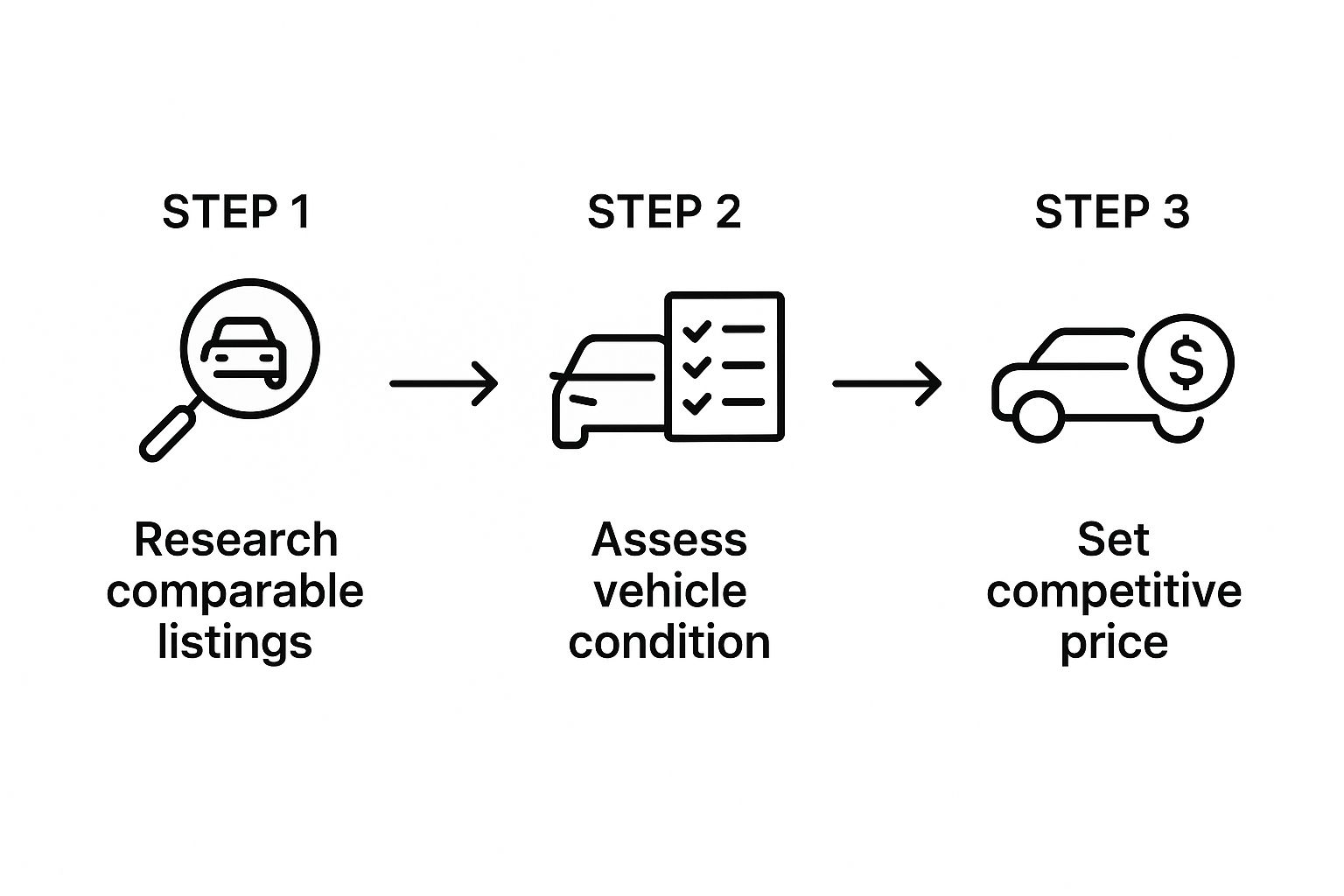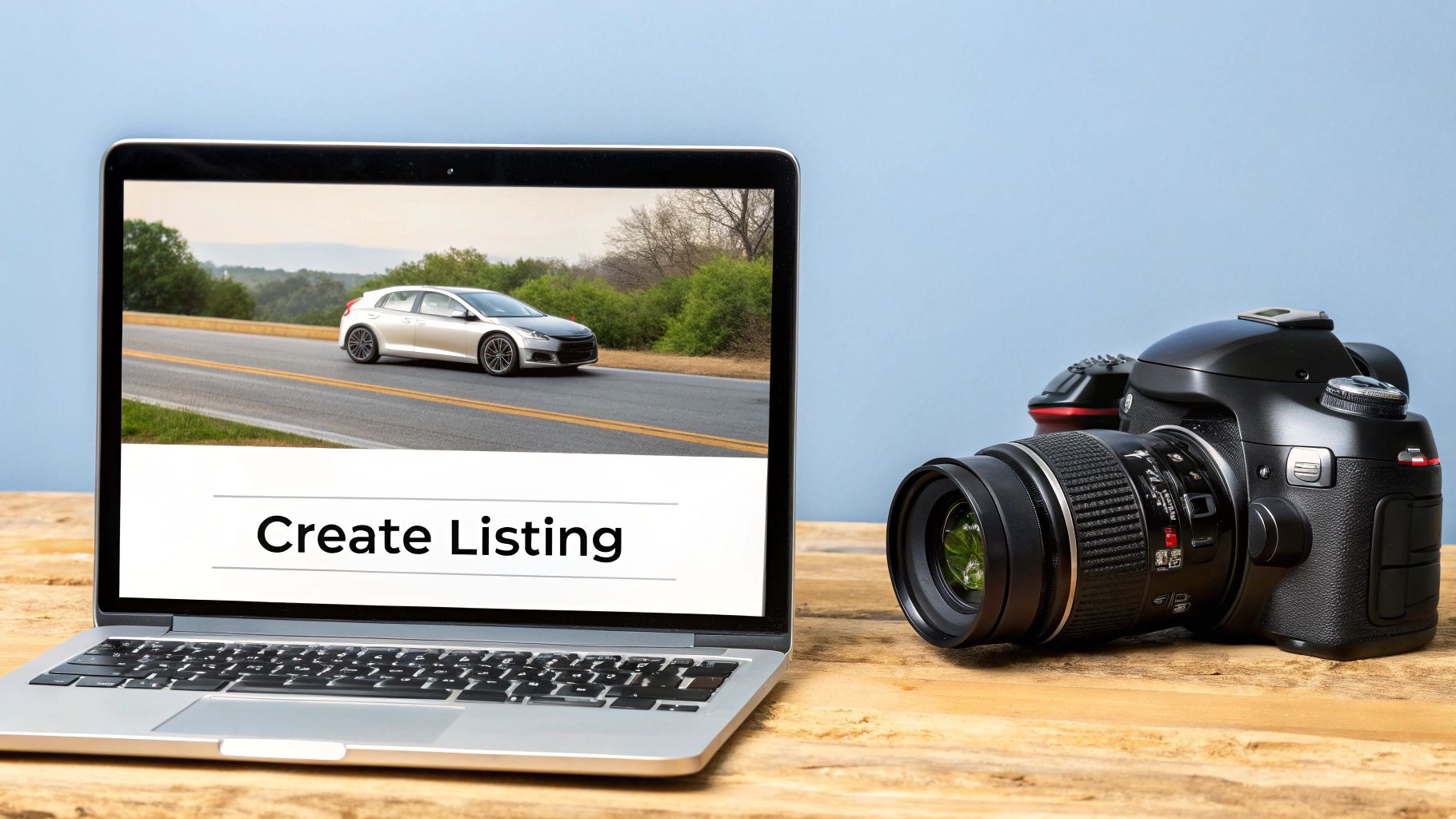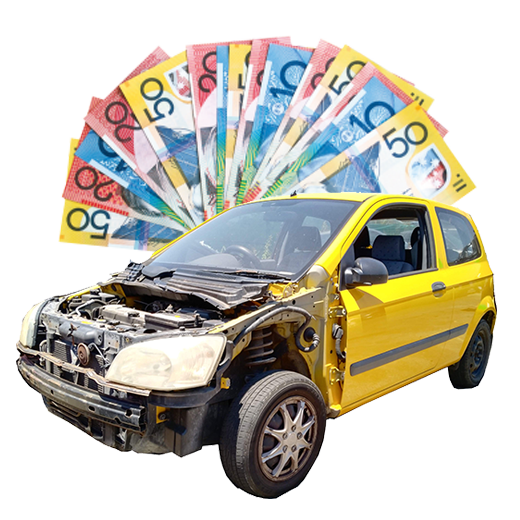When you're ready to sell your car privately, first impressions aren't just important—they're everything. It’s about more than just a quick run through the car wash. We're talking about the kind of preparation that genuinely adds to your car's value and gets serious buyers interested from the get-go.
Let's dive into the practical steps that will make your car look its absolute best, from getting the interior spotless to tackling those small cosmetic issues that can make a huge difference.
Staging Your Car for a Profitable Private Sale

Think of this process like staging a house before an open inspection. A sparkling clean, well-presented car doesn't just look better in photos; it sends a clear message to buyers that you've taken good care of it. This effort directly impacts how quickly you sell and for how much.
The first, and easiest, step is to completely declutter the interior. Get rid of every personal item. Check the glove box, centre console, door pockets, and even under the seats for forgotten odds and ends. A potential buyer needs to be able to picture themselves owning the car, not feel like they're sitting in yours.
The Deep Clean That Adds Value
While a professional detail is a great option if you're short on time, you can get fantastic results yourself with a bit of effort. The aim is to get the car looking as close to showroom condition as you possibly can.
- Tackle the Interior: Start by vacuuming every nook and cranny—carpets, seats, and the boot. Use the right cleaning products for the surfaces you have, whether it's cloth upholstery, leather, or plastic trim. Don't overlook the inside of the windows and the dashboard.
- Make the Exterior Shine: A thorough wash followed by a good wax is non-negotiable. Waxing doesn't just add a brilliant shine; it can also help fill in and hide very fine surface scratches. Give the wheels and tyres a proper clean and finish with a tyre shine product. It’s a small touch that makes a big impact.
- Don't Forget the Engine Bay: Popping the bonnet to reveal a clean engine bay can seriously impress a savvy buyer. You don't need to be a mechanic; a simple wipe-down to get rid of the obvious dust and grime shows you've cared for the car inside and out.
Handling Minor Cosmetic Fixes
Little things like stone chips and scuffs can give a buyer the perfect excuse to haggle you down. Taking care of them beforehand demonstrates your attention to detail and reinforces your asking price. A touch-up paint pen is perfect for small chips, and a headlight restoration kit can work wonders on foggy or yellowed lenses. These are cheap fixes that can massively boost your car's perceived value.
A car that looks cared for is a car that buyers are willing to pay more for. Investing a weekend in preparation can easily add hundreds of dollars to your final sale price by building immediate trust.
Organise Your Paperwork
Trust is the currency of private sales. Having all your paperwork in order is one of the best ways to build confidence. Get everything together: your logbooks, the complete service history, and any receipts for significant work like new tyres or a recent brake job. A folder full of records is solid proof of diligent ownership. For anyone in Adelaide, mastering these prep steps is crucial when you decide to sell my car Adelaide quickly and for the right price.
Once your car is looking its best, your presentation needs to carry over to your online ad. Since visuals are king on platforms like Facebook Marketplace, consider getting some help to make your photos pop. Exploring quality Facebook Marketplace photo editing services can give you a professional edge and help your listing truly stand out from the competition.
How to Value and Price Your Car to Sell
Getting the price right is probably the trickiest part of selling a car yourself. Ask for too much, and your phone will stay silent. Go too low, and you're just giving away your hard-earned cash. The secret is finding that sweet spot, which comes down to a bit of research, a lot of honesty about your car's condition, and a feel for what's happening in the market right now.
Sure, you can start with an online valuation tool. They’re a decent first step to get a rough idea. But remember, these calculators are just spitting out a number based on the basics—make, model, year, and kilometres. They have no idea about the full service history you've kept, the pristine interior, or whether your specific model is in high demand in your neighbourhood. Think of it as a starting point, not the final word.
Analyse the Live Market
The best way to know what your car is worth is to see what similar ones are actually selling for. This is where you become the expert. Jump onto sites like Carsales and Gumtree and act like you're a buyer looking for your exact car.
When you're searching, get as specific as you can:
- Make, Model, and Year: This is your foundation.
- Kilometres: Look for cars with similar mileage. A big difference here can swing the price by thousands.
- Trim Level and Features: A top-tier model with all the extras (think leather seats, sunroof, premium sound system) will always fetch more than the base model.
- Condition: Now, be brutally honest. How does your car really look compared to the ones in the ads? Scrutinise the photos.
This little bit of homework will give you a very real-world price bracket. For example, if you find five sedans just like yours listed between $12,000 and $14,000, you can be pretty sure that listing yours for $18,000 isn't going to get you anywhere.
This infographic breaks down a simple, three-step approach to help you land on a competitive price.

By blending real market data with a straight-up assessment of your car, you can set an asking price that feels both fair and strategic.
Factor in Current Trends and Your Car's Condition
The wider car market has its own moods, and they can definitely affect your sale. The Australian market is constantly changing. For instance, as of August 2025, overall new car sales dipped slightly by 0.1%, but some brands like BYD have shot up, which tells you where buyer interest is shifting. Keeping an ear to the ground on these trends, which you can track on sites like focus2move.com, helps you position your car smartly.
Pro Tip: Always set your asking price a little higher than the lowest you’re willing to accept. This gives you some wiggle room for negotiation. A 5-10% buffer is a good rule of thumb.
Finally, it’s time to put a number on it. If similar cars are going for $13,000 to $15,000 and yours is a gem with low kilometres and a perfect service book, go ahead and price it at the top of that range. On the other hand, if it’s got a few dings and scratches, pricing it competitively in the lower half will attract buyers who are hunting for a bargain.
Remember, figuring out where to sell your vehicle is just as crucial as the price, because different platforms draw different crowds.
Crafting an Advertisement That Gets Responses

Think of your online ad as your car's first interview. It's your single best chance to make a great impression and get serious buyers to pick up the phone. A compelling ad does more than just list the facts; it builds trust and tells a story, starting with the very first thing people will see: the photos.
You don't need to be a professional photographer to get this right. Your smartphone is more than up to the task. The secret is all in the lighting and the angles you choose.
My best tip? Avoid shooting in the harsh midday sun. It creates weird reflections and deep shadows that hide the car's true shape and can make the paint look terrible. Instead, head out during the "golden hour"—that soft, warm light you get just after sunrise or before sunset. It makes any car look a million bucks, highlighting its lines and showing off the true colour.
The Shots That Every Buyer Wants to See
To build a complete picture for a potential buyer, you need to show them everything. Aim for a gallery of at least 15-20 high-quality photos. This shows you have nothing to hide and answers most of their initial questions before they even ask.
- The Full Tour: Get shots of all four corners of the car, plus straight-on photos of the front, back, and both sides.
- A Look Inside: Open the doors and capture the dashboard and driver's area, the back seats, and the boot. Don't forget close-ups of the odometer (to show the kilometres), the infotainment system, and any cool features like a sunroof or leather seats.
- Wheels and Tyres: A clear photo of each wheel and its tyre tread is a must. It shows attention to detail.
- Honesty is Key: If there’s a small scratch on the bumper or a stone chip on the bonnet, take a photo of it. Being transparent about minor imperfections builds instant credibility and prevents awkward surprises during an inspection.
A detailed and honest set of photos acts as a fantastic filter. It weeds out the tyre-kickers and ensures that the people who contact you are genuinely interested and know what to expect.
Writing a Description That Sells
Once your photos have grabbed their attention, a well-written description will seal the deal. You need to balance being informative with being persuasive.
First, get the must-have details out of the way. These are the things people will use to filter their search results, so make sure they're right at the top and easy to find. The table below covers all the essentials you'll need to include.
Essential Details for Your Vehicle Advertisement
Use this checklist to ensure your online listing includes all the key information to attract serious buyers and reduce unnecessary questions.
| Information Category | Details to Include | Why It Matters |
|---|---|---|
| Vehicle Basics | Year, Make, Model (e.g., 2018 Toyota Camry) | The most critical search filters for buyers. |
| Specifics | Trim Level (e.g., Ascent Sport), Transmission | Narrows the search and targets buyers looking for specific features. |
| Condition & Usage | Current Kilometres, Registration Expiry Date | Gives an instant snapshot of the car's life and immediate costs. |
| Service History | Mention of logbooks, recent major services | Builds confidence that the car has been well-maintained. |
| The Deal | Asking Price (e.g., $22,500 ONO) | Clearly states your expectation and opens the door for negotiation. |
With the key stats covered, it's time to bring the car's story to life. People connect with stories, not just spec sheets.
Explain why you're selling—a simple, honest reason like "needing a bigger car for our growing family" or "moving overseas" works perfectly. Highlight what you've loved about owning it, whether it's the fantastic fuel economy on your commute or the premium sound system. If you're the first or second owner, that's a huge selling point, so be sure to mention it. This personal touch helps your ad stand out from the hundreds of others that are just a dry list of features.
Right, your ad is live. Now comes the part where the rubber meets the road: dealing with calls and messages, and arranging test drives. This is where you shift from marketer to negotiator, and it’s crucial to balance being open and friendly with being cautious.
You’ll get all sorts. It doesn't take long to tell the genuine buyers from the tyre-kickers. Serious folks tend to ask specific, thoughtful questions about the car's service history, its features, or a particular detail they saw in the photos. The low-effort "still available?" messages? They rarely go anywhere.
Sorting the Serious from the Curious
Think of your first chat as a quick screening. I’ve always found that a five-minute phone call tells you more than twenty back-and-forth texts. It gives you a real feel for their personality and how serious they are about buying.
Listen to your gut. If someone comes in super aggressive on price before they’ve even laid eyes on the car, or if they're cagey about answering simple questions, those are big red flags.
Be ready to talk honestly about the car. This is also your chance to ask a few qualifying questions. A simple, "Just to check, do you have your finance sorted?" can save you a world of hassle. And always confirm they have a valid driver's licence before you go any further.
My Golden Rule: Never, ever agree to meet someone without speaking to them on the phone first. It’s a basic check to make sure they're a real person and gives you a much better sense of who you’re dealing with.
If you’ve got a few people on the go, it's easy to lose track. Using one of the many follow-up reminder apps can be a lifesaver for keeping conversations and appointments organised.
Your Test Drive Safety Checklist
Let's be clear: your personal safety is paramount. You're meeting a complete stranger and letting them drive your car. A few simple precautions aren't over the top—they're just smart.
Here’s the safety protocol I stick to every single time:
- Meet on Neutral Ground: Don't give out your home address. Pick a busy, public place like a local shopping centre car park. It keeps your private life private and provides a much safer environment for both of you.
- Licence First, Keys Second: Before they even think about getting in the driver's seat, ask to see their driver's licence. Snap a quick photo of the front and back and text it to a partner or mate, along with your location and rough plan.
- You're the Co-Pilot: Never let a buyer go for a solo test drive. Always ride along in the passenger seat. If anything feels off, trust your instincts and politely end the drive.
- Set the Terms: A test drive isn't a weekend road trip. Let them know you've got about 15-20 minutes and suggest a route you're familiar with. This keeps things controlled and on schedule.
The Art of the Deal: Nailing the Negotiation and Getting Paid

Alright, this is the part that often feels a bit daunting—the haggle. But honestly, it doesn't have to be a standoff. If you’ve done your homework and priced your car fairly, you’re walking into this conversation with all the confidence you need. Just remember, almost everyone will try to negotiate; it’s just part of the game when you sell a car privately.
The first offer you hear is almost never the buyer's best. A classic move is the "low-ball" offer, where they throw out a number well below what you're asking, just to test the waters. The key is not to get offended. Just give them a polite but firm, "Thanks for the offer, but I can't let it go for that." You can then either restate your price or come back with a counteroffer that’s still comfortably in your ballpark.
This is exactly why you built that 5-10% buffer into your asking price. It gives you some wiggle room to make the buyer feel like they got a good deal, without you losing out.
Know Your Worth and Find the Sweet Spot
Your strongest asset in any negotiation is knowing exactly what your car is worth and why. Be ready to calmly point out all the things that justify your price—the complete logbook, those brand new tyres you just put on, or its super low kilometres. This shows your price is based on the car's genuine value, not just a number you plucked from thin air.
What's happening in the wider market can also give you an edge. For instance, SUVs are absolutely dominant in Australia right now, holding a huge 60.7% market share as of August 2025, while traditional passenger cars have seen a big dip in sales. If you're selling a sought-after SUV, you can mention its popularity to hold firm on your price. It helps to keep up with the latest Australian car market trends to know where you stand.
At the end of the day, a good deal is one where both you and the buyer walk away happy. A little bit of flexibility might be all it takes to close the deal with a serious, genuine buyer.
How to Get Paid Without Getting Scammed
Once you've agreed on a price and shaken hands, the final—and most critical—step is getting the money into your account safely. You need to be on high alert for scams here.
My golden rule: Never, ever hand over the keys, the registration papers, or any other documents until you have confirmed the full payment has cleared and is sitting in your bank account. No exceptions.
Here are the safest ways I've found to handle the payment:
- Bank Cheque: This is a solid option. The best way to do it is to go with the buyer to their bank and physically watch the teller draw up the cheque. It’s about as secure as it gets.
- Direct Bank Transfer: An electronic transfer using PayID or a standard transfer is fast and common. Do the transfer while you're both together and don't let them leave until you see the money appear as cleared funds in your account. A "pending" transaction isn't good enough.
- Cash: Cash can work, especially for cars under $10,000. For larger sums, I always insist on meeting the buyer at my bank. You can deposit it on the spot, and the teller will check for counterfeit notes.
As soon as the money is confirmed, draw up a proper receipt. It doesn't need to be fancy, but it absolutely must include the date, final sale price, the car's details (make, model, and VIN), and the full names and signatures of both you and the buyer. This simple document is your proof of sale and protects everyone involved.
Completing the Paperwork to Finalise the Sale
You’ve got the money in your account, and the deal is done. But don't pop the champagne just yet. This last part—the paperwork—is absolutely critical for protecting yourself legally.
Getting the transfer of ownership right means you won't be on the hook for any speeding fines or toll charges the new owner racks up on their way home. It’s the final, and most important, step to a clean break.
Every state and territory in Australia has its own way of doing things, so you absolutely must check the rules for where you live. The basic idea is the same everywhere, though: you have to officially tell the local transport authority that the car is no longer yours.
This usually means filling out a section on the back of the registration papers or a separate transfer form. Both you and the buyer need to sign it. Most importantly, write down the exact date and time of the sale. That little detail is your golden ticket if the new driver runs a red light five minutes after leaving your driveway.
What's the Deal with Roadworthy Certificates?
One of the biggest questions people have is about the Roadworthy Certificate (RWC), which you might know as a safety certificate or a pink slip. This is just a certificate from an authorised mechanic confirming your car has passed a basic safety check.
Whether you need one comes down to your state and the car's age. The rules vary wildly.
- In places like Queensland and Victoria, you generally must provide a current RWC to the buyer if the car is registered. It's not optional.
- New South Wales is a bit different. You need a pink slip for your annual registration renewal, but you don't always need a new one just to sell the car, unless the rego has lapsed.
- Over in South Australia and Western Australia, you typically don't need to worry about an RWC for a standard private sale.
Don't guess on this. Failing to provide an RWC when it's required can get you fined or even void the sale. Check your state’s transport authority website for the current rules. If you're in a tricky situation, finding out if you can sell a car without a roadworthy can shed more light on your specific obligations.
The Final Handover Documents
Aside from the official government forms, you need to create your own receipt or contract of sale. Make two copies—one for you, one for the buyer—and make sure you both sign them.
A simple, clear receipt is your best friend if any disagreements pop up later. It formally documents the sale and confirms the car was sold "as is, where is," protecting you from comeback claims once they've driven off.
Make sure your receipt has all of this information:
- Full Vehicle Details: The make, model, year, VIN, and registration number.
- Buyer and Seller Information: Full names, addresses, and driver's licence numbers of both parties.
- Sale Details: The final price, the date, and the exact time of the transaction.
- A Declaration: A crucial sentence like, "The vehicle is sold in 'as is' condition without warranty."
It might feel like a bit of a bureaucratic headache, but nailing this paperwork is what separates a smooth sale from a future nightmare. It’s especially important in today's market, where private sales are booming. Just to give you an idea, in July 2025, private buyers snapped up 7,279 utes across Australia. That’s a huge increase from the year before and shows just how active the private market is. You can discover more insights about these Australian car sales trends and see why a professional approach matters.
If all this sounds like more trouble than it's worth, or if your car is old, broken, or just taking up space, there's a much easier way. Auto Removal Adelaide offers a fast and simple alternative. We pay instant cash for cars in any condition and handle the free vehicle removal across Adelaide. Get in touch today for a no-obligation quote at https://autoremovaladelaide.com.au.


